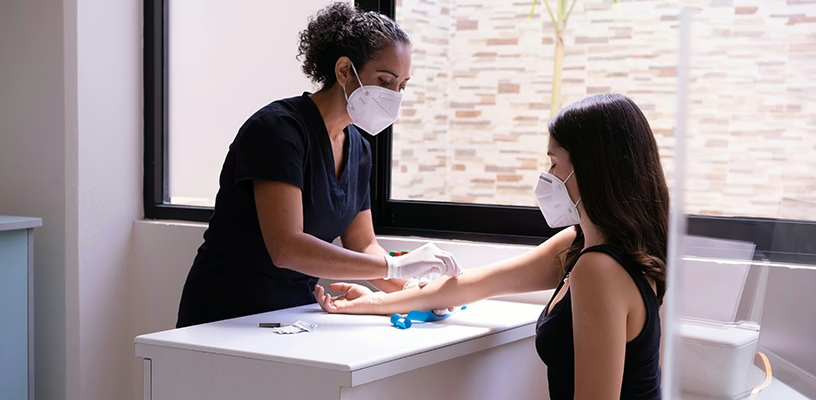Signs You Passed Your Glucose Test for Gestational Diabetes
Your doctor will track your health throughout your pregnancy to ensure everything is progressing as it should. One check that you’ll need is a glucose test for gestational diabetes.

You might find it confusing when you learn you need to take this, especially if you’ve never had diabetes in your life. However, this necessary and important test protects you and your baby from risks down the road.
Read on to learn what exactly gestational diabetes is, why the glucose test is important, and what you can do to maintain your glucose levels during your pregnancy.
What is gestational diabetes?
Gestational diabetes (GD) is a fairly common condition among pregnant women. It affects about 5%–9% of moms-to-be in the US. 1 Even women who don’t have diabetes before conceiving can develop it during pregnancy because of their hormonal changes. 2
Like all forms of diabetes, GD is a big deal. If you ignore it and don’t get proper treatment, it can increase the risk of several complications for both you and your baby, including: 2
- Fetal macrosomia: This means developing an overweight baby (over 9 pounds at birth). It can lead to difficult delivery, heavy bleeding post-delivery, and severe tearing in the vagina—or the need for a C-section.
- High blood pressure: High blood pressure during pregnancy is bad for the heart and kidneys. It also increases the risk of preeclampsia, which can lead to premature birth.
- Long-term health risks: If you have GD, it’ll typically go away after you give birth. However, it’ll have lasting effects on your health. In particular, both of you will have a higher chance of developing diabetes in the future.
- Newborn complications: Your baby might have jaundice, trouble breathing, or low blood sugar at birth. He’ll also be more likely to experience birth trauma, such as shoulder damage during vaginal birth.
- Stillbirth: In severe (and rare) cases, GD can lead to stillbirth.
The good news is that gestational diabetes is usually manageable, often through lifestyle changes (more on that later). As long as you diagnose it early enough and follow the right approach, you’ll likely have a healthy pregnancy and baby.
What is the glucose screening test?
A glucose screening test is a standard prenatal test for gestational diabetes (GD). It checks the level of glucose (sugar) in your blood to see if it’s higher than normal.
If your results are abnormal, it means you might have gestational diabetes or a risk of developing it. Your doctor may ask you to take further tests to determine if you actually have GD.
When do you take the glucose screening test?
You’ll usually take the glucose screening test between weeks 24 and 28 of your pregnancy. However, your doctor might ask you to test earlier if you: 3 1
- Are obese
- Are 35 years old or older
- Are African American, Native American, Hispanic or Latino, Native Hawaiian, Alaska Native, or Pacific Islander
- Have a family history of type 2 diabetes
- Have a high glucose level in your urine
- Have birthed a baby over 9 pounds before
- Have polycystic ovary syndrome (a hormone disorder)
- Had gestational diabetes in a prior pregnancy
If you match one or more of the descriptions above, you have a higher chance of developing gestational diabetes, so it makes sense to screen you for it more aggressively.
Are there any risks to the glucose screening test?
The glucose screening test is safe and rarely causes any serious side effects. However, you may feel a bit uncomfortable during the procedure. 3
The test involves drinking a sugary drink—a glucose solution—which is like a very sweet soda. You might feel a little nauseous, sweaty, or lightheaded after drinking it.
The discomfort is temporary and usually goes away after you eat. That said, it’s a good idea to bring someone with you to the test in case you have any side effects.
Can you skip the glucose screening test?
You have the right to skip the glucose screening test, but it’s best not to. According to the American College of Obstetricians and Gynecologists (ACOG), all pregnant women should take the test to make sure they have safe pregnancies. 2
Since many women don’t have clear gestational diabetes symptoms, testing is the only way to detect it. Fortunately, the screening procedure is very easy and effective.
Do you have to prepare for your glucose test?
Whether you need to prepare for your glucose test depends on your doctor’s testing method. You might have to fast in the hours leading up to your test.
If you’re unsure which test you’re having, just ask your doctor. They’ll let you know if you need to follow any special instructions.
What is taking the glucose test actually like?
There are two approaches to glucose testing: the two-step method and the one-step method. Your doctor will tell you which you’ll use. 3
Two-step method
For the two-step method, you don’t need to fast or change up what you eat before or on the day of the test. Just keep eating whatever (hopefully healthy!) foods you’re settled on for your pregnancy diet, show up at the medical center, and:
- Drink a sugary drink that contains glucose (often about 50 grams).
- Wait for an hour after drinking the glucose solution.
- Have your doctor or nurse draw your blood to check your blood sugar level.
If your glucose levels are within the normal range, congratulations! It means you’re healthy and don’t need to take the second test.
If your levels are too high, it doesn’t necessarily mean you have gestational diabetes. You’ll need to take a second test—the oral glucose tolerance test—to be sure.
Step two: the oral glucose tolerance test
If you don’t pass the first test, your doctor will ask you to take a three-hour oral glucose tolerance test. Here’s how it’ll go:
- You won’t be able to eat (or drink anything other than sips of water) for 8–14 hours before your test. You can’t eat during the test, either.
- A doctor or nurse will draw your blood (before you drink the glucose solution).
- You drink the same sugary drink, although this time, it’ll contain 100 grams of glucose.
- Your doctor or nurse will draw your blood 3 times every hour after you drink the solution. They’ll check your glucose level each time.
The results from this second test will confirm if you actually have gestational diabetes or if the results from the first test were just a false alarm.
One-step method
This method will take at least 2 hours.
- You can’t eat or drink anything other than sips of water 8–14 hours before your test. You can’t eat during the test, either.
- A healthcare provider will draw your blood (before you drink the glucose solution).
- You drink a sugary drink that contains 75 grams of glucose.
- A healthcare provider will draw your blood 2 times every hour after you drink the solution. They’ll check your glucose level each time they draw your blood.
How to read your glucose test results
The numbers on your test results aren’t as confusing as they might seem. Here’s what they mean. 3
Two-step method results (the first test)
In most cases, a blood sugar level of 140 mg/dL (7.8 mmol/L) or lower is normal. Some doctors use a lower threshold (e.g., 130 mg/dL) to catch more potential cases of gestational diabetes.
Again, if your test results aren’t within the normal range, you’ll need to take the oral glucose tolerance test for a more definite diagnosis.
Oral glucose tolerance test results
You likely have gestational diabetes if three or more of your results are in the abnormal range, as shown below:
- Fasting: 95 mg/dL (5.3 mmol/L) or higher
- 1 hour: 180 mg/dL (10 mmol/L) or higher
- 2 hours: 155 mg/dL (8.6 mmol/L) or higher
- 3 hours: 140 mg/dL (7.8 mmol/L) or higher
One-step method results
Similarly, you probably have gestational diabetes if one or more of your results are in the abnormal range:
- Fasting: 92 mg/dL (5.1 mmol/L) or higher
- 1 hour: 180 mg/dL (10 mmol/L) or higher
- 2 hours: 153 mg/dL (153 mmol/L) or higher
What happens if you’re diagnosed with gestational diabetes?
Don’t panic if you’re diagnosed with gestational diabetes. Your doctor will talk to you about how to manage it. Here are some common strategies: 2
- Home blood glucose monitoring: You may need to check your blood sugar levels regularly using a home blood glucose meter.
- Eat healthy: You can work with a registered dietitian to come up with a personalized diet plan that keeps your blood sugar levels stable.
- Exercise regularly: If you’re already fairly active, that’s great—but if you’re not big on exercising, you’ll need to change your habits. Being active helps keep your blood sugar levels under control.
- Medication: In some cases, changing your diet and exercise habits alone won’t be enough to control your blood sugar. If so, your doctor may prescribe medication, such as insulin or metformin. 1
Pregnant women with GD may also need more prenatal visits than those who don’t have it. This lets your doctor closely monitor your condition and modify your treatment plans if necessary.
More tips for managing your blood sugar
Even if your glucose test results are normal and you don’t have GD, it’s worth following these tips to keep your body at its best:
- Choose complex carbs: Replace simple carbohydrates (e.g., sugary cereals and pastries) with complex carbohydrates (whole grains, fruits, and vegetables). Your body will have fewer blood sugar spikes because it digests complex carbs more slowly. 4
- Get moving: A good rule of thumb is to aim for at least 30 minutes of moderate cardio exercise (e.g., walking or swimming) 5 days a week. Throwing in a short 10–15 minute walk after meals is even better. 2
- Monitor your weight gain: You’re at risk of gestational diabetes if you gain too much weight during pregnancy. Talk to your doctor about what your healthy weight gain range is and do your best to stick to it.
Final thoughts
While getting your blood drawn isn’t the most fun part of pregnancy, a glucose test is a necessary step to ensure everything is progressing smoothly. Even if you don’t like needles, you shouldn’t skip this one—it’s an easy way to protect you and your baby from pregnancy complications and long-term health risks.
Again, if you do find out you have gestational diabetes (or you’re at risk of developing it), stay calm. The condition is usually temporary, and it’s very treatable, as long as you follow your doctor’s advice.
Article Sources
- U.S. Centers for Disease Control and Prevention. "Gestational Diabetes" Retrieved April 24, 2025.
- American College of Obstetricians and Gynecologists. "Gestational Diabetes" Retrieved April 24, 2025.
- MedlinePlus. "Glucose screening tests during pregnancy" Retrieved April 24, 2025.
- U.S. Centers for Disease Control and Prevention. "Choosing Healthy Carbs" Retrieved April 24, 2025.







